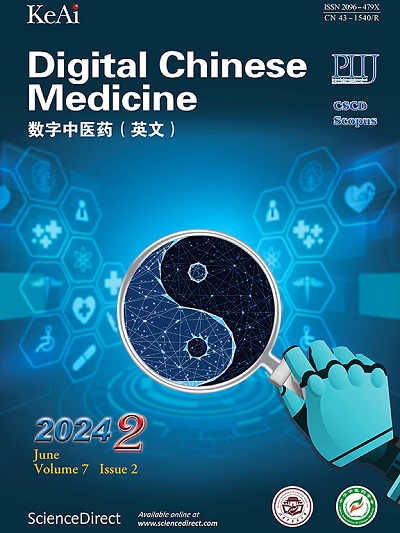基于分子对接分析的薯蓣根提取物体外抗糖尿病活性评价
Q3 Medicine
引用次数: 0
摘要
目的评价薯蓣根提取物的体外抗糖尿病作用,包括水丙酮提取物及其乙酸乙酯和丁醇组分,以及氯仿-甲醇提取物。方法采用比色法,分别用福林-乙醇试剂、三氯化铝试剂和香兰素试剂测定薯蓣根提取物(氯仿-甲醇提取物、水-丙酮提取物及其乙酸乙酯和丁醇组分)中总酚、类黄酮、黄酮醇和皂苷的含量。通过测定这些根提取物对α-淀粉酶和α-葡萄糖苷酶活性的半最大抑制浓度(IC50)值,评价其对α-淀粉酶动力学的影响,用荧光法定量测定牛血清白蛋白(BSA)糖基化的抑制作用以评估晚期糖基化终产物(AGE)的产生,并测定离体大鼠半横肌的葡萄糖摄取,来评估其体外抗糖尿病活性。此外,通过分子对接分析,研究了薯蓣配体(葫芦素B、豆芽胞苷、牡荆素和异牡荆素)与靶酶的结合亲和力和相互作用类型,构建了植物化学-靶点相互作用网络。结果乙酸乙酯部位对α-淀粉酶的抑制作用最强(IC50 = 145.95 μg/mL),氯仿甲醇部位次之(IC50 = 300.86 μg/mL)。水丙酮根提取物及其乙酸乙酯和丁醇组分抑制α-葡萄糖苷酶活性,IC50值为562.88 ~ 583.90 μg/mL。乙酸乙酯和丁醇组分均能显著抑制非酶促BSA糖基化(IC50分别为318.26和323.12 μg/mL)。乙酸乙酯部分(5 mg/mL)孵育离体大鼠半膈,显著增加葡萄糖摄取(35.16%;P & lt;0.0001),超过胰岛素(29.27%)、氯仿甲醇提取物(24.07%)和儿茶素(15.27%)的效果。分子对接结果表明,葫芦素B对α-淀粉酶(- 16.4 kcal/mol)和α-葡萄糖苷酶(- 14.2 kcal/mol)的对接得分最高。与其他配体相比,异vitexin与α-淀粉酶活性位点残基(Asp300、Asp197、Glu233)、α-葡萄糖苷酶残基(Ser13、Arg44、Met86、Gly10、Asp39、Tyr131)和其他残基(Arg195、Trp59、His299、Tyr62)形成的氢键数最多。网络分析发现,薯蓣植物化学物质与2型糖尿病相关基因之间存在36个重叠靶点,葫芦素和多酚类物质与α-淀粉酶、α-葡萄糖苷酶和Glut4易位途径靶点相互作用。结论薯蓣根提取物具有良好的体外抗糖尿病活性,其机制包括对消化酶的抑制作用、对蛋白质的抗糖基化作用、对葡萄糖摄取的增强作用等,具有开发抗糖尿病药物的潜力。本文章由计算机程序翻译,如有差异,请以英文原文为准。
Evaluating the in vitro anti-diabetic activity of Bryonia dioica root extracts supported by molecular docking analysis
Objective
To evaluate the in vitro anti-diabetic effects of Bryonia dioica roots extracts, including water-acetone extracts and their ethyl acetate and butanol fractions, and chloroform-methanol extracts.
Methods
The total phenolic, flavonoid, flavonol, and saponin contents in the Bryonia dioica root extracts (chloroform-methanol extracts, water-acetone extracts and their ethyl acetate and butanol fractions) were determined using colorimetric methods with Folin-Ciocalteu, aluminum trichloride, and vanillin reagents, respectively. The in vitro anti-diabetic activity was evaluated by measuring the half-maximal inhibitory concentration (IC50) values of these root extracts against α-amylase and α-glucosidase activities, evaluating their effects on α-amylase kinetics, quantifying the inhibition of bovine serum albumin (BSA) glycation using fluorometry to assess advanced glycation end products (AGE) production, and determining glucose uptake by isolated rat hemidiaphragm. Additionally, molecular docking analysis was conducted to investigate the binding affinity and interaction types between Bryonia dioica ligands (cucurbitacin B, bryogénin, vitexin, and isovitexin) and target enzymes, and a phytochemical-targets interaction network was constructed.
Results
For α-amylase inhibition, ethyl acetate fraction demonstrated the most potent activity (IC50 = 145.95 μg/mL), followed by chloroform-methanol extract (IC50 = 300.86 μg/mL). Water-acetone root extracts and their ethyl acetate and butanol fractions inhibited the α-glucosidase activity with IC50 values ranging from 562.88 to 583.90 μg/mL. Both ethyl acetate and butanol fractions strongly inhibited non-enzymatic BSA glycation (IC50 = 318.26 and 323.12 μg/mL, respectively). The incubation of isolated rat hemidiaphragms with the ethyl acetate fraction (5 mg/mL) significantly increased glucose uptake (35.16%; P < 0.0001), exceeding the effects of insulin (29.27%), chloroform-methanol extract (24.07%), and catechin (15.27%). Molecular docking revealed that cucurbitacin B exhibited the strongest docking scores against α-amylase (– 16.4 kcal/mol), and α-glucosidase (– 14.2 kcal/mol). Compared with other ligands, isovitexin formed the maximum number of hydrogen bonds with the α-amylase active site residues (Asp300, Asp197, and Glu233), α-glucosidase residues (Ser13, Arg44, Met86, Gly10, Asp39, and Tyr131) and other residues (Arg195, Trp59, His299, and Tyr62). Network analysis identified 36 overlapping targets between Bryonia dioica phytochemicals and type 2 diabetes mellitus-associated genes, with cucurbitacins and polyphenols interacting with α-amylase, α-glucosidase, and Glut4 translocation pathway targets.
Conclusion
Bryonia dioica root extracts demonstrated promising in vitro anti-diabetic activity through multiple mechanisms, including the inhibitory effect on digestive enzymes, protein antiglycation potential, and enhancement of glucose uptake, suggesting their potential as a source for anti-diabetic drugs development.
求助全文
通过发布文献求助,成功后即可免费获取论文全文。
去求助
来源期刊

Digital Chinese Medicine
Medicine-Complementary and Alternative Medicine
CiteScore
1.80
自引率
0.00%
发文量
126
审稿时长
63 days
期刊介绍:
 求助内容:
求助内容: 应助结果提醒方式:
应助结果提醒方式:


